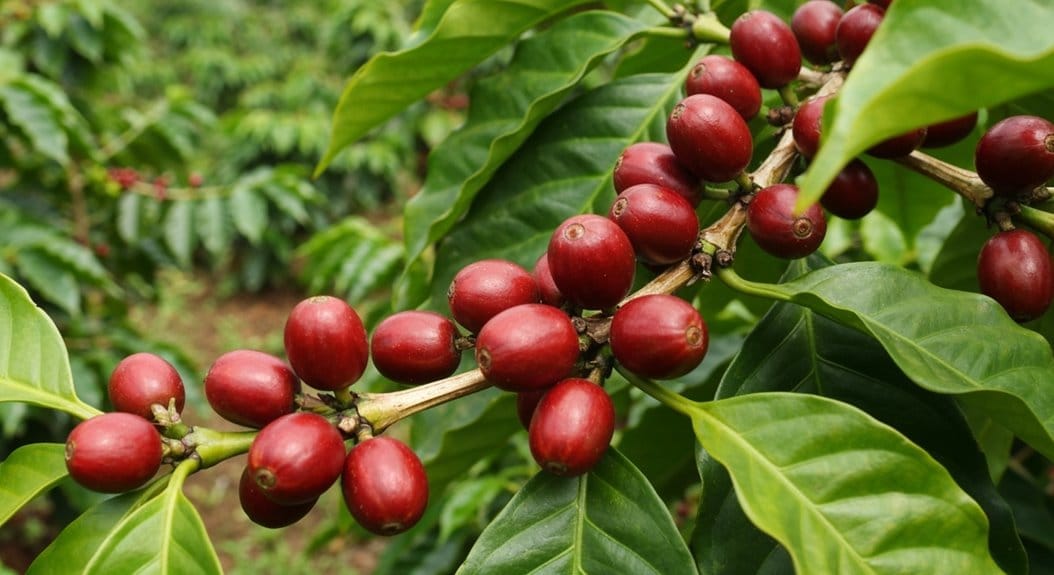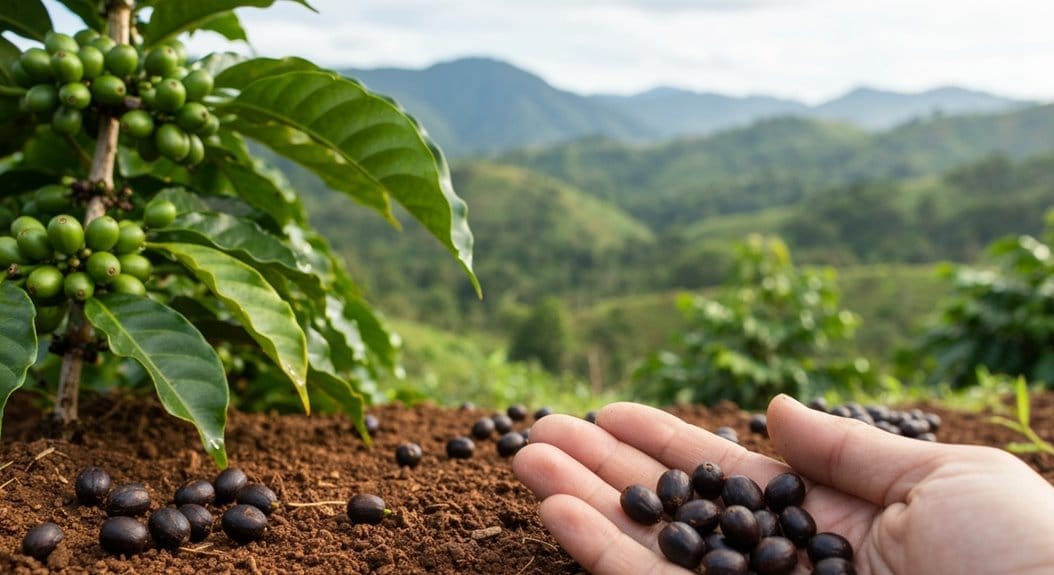Pacamara coffee? Oh boy, it’s a real gem from El Salvador—it’s like the Hulk of coffee beans! Seriously, these beans are gigantic and are a mix of Pacas and Maragogipe varieties. You get fruity, honey, and spicy flavors that’ll kick your taste buds into action. But the cultivation? It’s not a walk in the park; these divas need perfect conditions and constant care. Keep following along, and you’ll uncover why this coffee is turning heads everywhere!
Key Takeaways
- Pacamara coffee is a hybrid variety developed in El Salvador, resulting from a cross between the Pacas and Maragogipe varieties.
- The beans are notably larger than typical Arabica beans, offering an elongated, oval shape that enhances their visual appeal.
- Their flavor profile is complex, featuring tropical fruits, honey, and spicy notes, creating a delightful tasting experience.
- Cultivation requires specific conditions such as high elevations, volcanic soils, and meticulous care to maintain genetic integrity.
- Economic challenges, labor shortages, and climate change threaten the future production of Pacamara coffee.
The Origin of Pacamara Coffee
When you sip on a cup of Pacamara coffee, it’s like holding a little piece of history in your hands—no kidding!
This delightful brew has roots that curl back to mid-20th century El Salvador, where the Salvadoran Institute for Coffee Research, or ISIC (sounds fancy, right?), wasn’t just brewing coffee; they were conducting a full-on science experiment!
They crossed two varieties, Pacas and Maragogipe, to create Pacamara—think of it as coffee’s version of a superhero team-up. Its genealogy stems from Coffea Arabica, incorporating flavors that reflect its rich heritage.
And here’s the kicker: Pacamara means blending cultures and histories, weaving a narrative that’s as rich as its flavor.
It’s not just coffee; it’s a reflection of the agricultural artistry of its creators. Talk about having a sip of culture!
Distinctive Bean Characteristics
Sipping on a cup of Pacamara coffee is like meeting a celebrity who’s also a high achiever—you can’t help but notice everything about them!
The beans are definitely a showstopper, with their unique attributes making them stand out in the coffee crowd.
- Bean dimensions: These beans are gigantic, much larger than your average Arabica!
- Shape: Their elongated, oval form gives them an ‘oversized’ charm.
- Flavor nuances: Expect a whirlwind of flavors—think tropical fruits, honey, and even some spicy vibes!
- Visual appeal: Their striking size brings a sense of elegance to any coffee feast.
Each sip invites you to appreciate the impressive journey from farm to cup, as you revel in their delicious complexity!
Ideal Cultivation and Processing Techniques

Cultivating Pacamara coffee really feels like a high-stakes coffee drama! It’s got these diva-like demands, thriving only at elevations of 1,200 to 1,800 meters, where volcanic soils work their magic—talk about high maintenance!
Those delicate plants need careful poking and prodding, with annual pruning and a fancy plant architecture that keeps them standing tall and healthy. Oh, and let’s not forget the fertilization strategies! Think of them as feeding your high-maintenance friend—balance is key. Too little, and they get cranky; too much, and you’re calling the coffee rescue team!
Plus, these prima donnas shouldn’t mingle with others—got to keep that genetic flair intact! Basically, Pacamara is like the Beyoncé of coffee beans—irreplaceable and unforgettable!
Roasting Precision and Flavor Profile
Roasting Pacamara coffee beans can feel like steering through a treasure map full of twists and turns, especially regarding figuring out that sweet spot for temperature and heat management.
Roasting Pacamara coffee beans is like navigating a treasure map, full of twists in the quest for the perfect temperature.
It’s a delicate dance, really!
- You start warmer than usual to kick things off.
- Then, airflow becomes your trusty sidekick, ensuring even roasting without the dreaded scorch.
- Watch that heat like a hawk; it can turn your brew from delightful to disaster fast!
- Ultimately, understanding the roasting profiles allows for that knockout flavor development.
With these elements in play, the result is a bright, fruity explosion—think apricot and orange—while keeping a syrupy chocolate body intact.
Who knew roasting coffee could be both an art and an amusing adventure?
Economic Challenges and Geographic Distribution

Steering through the world of Pacamara coffee isn’t just about crafting that perfect cup; it also means tackling some serious economic hurdles and tricky geography.
Can you imagine trying to grow high-quality beans while facing economic strain from fluctuating exchange rates? Yup, small-scale farmers often find themselves knee-deep in debt and short on cash, thanks to rising production costs.
And let’s talk about labor shortages! With fewer migrant workers making their way to coffee fields, those little beans might just be out of reach.
Plus, as climate change messes with rainfall patterns, it’s like Mother Nature’s taking coffee break!
Pacamara’s future rests on grappling with these challenges, proving that coffee farming isn’t just a grind—it’s a rollercoaster ride!
Frequently Asked Questions
How Does Pacamara Coffee Compare to Other Coffee Varieties in Taste?
Pacamara coffee’s taste profile stands out due to its flavor complexity, showcasing pronounced fruity brightness and bold sweetness. Compared to other varieties, it offers a richer mouthfeel and a more diverse range of flavors.
What Are the Best Brewing Methods for Pacamara Coffee?
The best brewing methods for Pacamara coffee include V60 and French Press. These techniques improve flavor extraction, showcasing its unique fruity notes while ensuring balanced acidity and a rich body through precise water temperature and grind size adjustments.
Can Pacamara Beans Be Grown Outside Central America?
Pacamara beans can be grown outside Central America, provided suitable growing regions replicate necessary environmental factors such as high altitudes, volcanic soils, and stable temperatures. Successful examples exist, yet challenges remain in broader adaptation and cultivation.
How Does Altitude Affect the Quality of Pacamara Coffee?
Altitude markedly influences bean quality in Pacamara coffee, with higher elevations enhancing flavor complexity, aroma, and acidity. Cooler temperatures slow maturation, while volcanic soils contribute nutrients, resulting in outstanding and distinctive flavor profiles commonly recognized in specialty competitions.
What Are the Most Common Flavor Notes in Pacamara Coffee?
The most common flavor profiles in Pacamara coffee include vibrant fruity tasting notes like peach and berry, alongside natural sweetness from caramel or chocolate. Floral and spiced nuances further enrich the coffee’s complexity and appeal.
References
- https://www.genuineorigin.com/guatemala-mario-jordan-pacamara-washed-shp-ep-2022
- https://library.sweetmarias.com/wp-content/uploads/2020/08/Exploring-Distinctive-Characteristics-Virtues-of-Coffee-Varieties-The-Bourbon-Pacamara-Case.pdf
- https://perfectdailygrind.com/2023/03/could-el-salvador-become-a-boutique-coffee-origin/
- https://apps.fas.usda.gov/newgainapi/api/report/downloadreportbyfilename?filename=Coffee+Annual_Guatemala+City_Guatemala_5-11-2015.pdf





